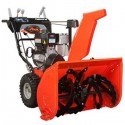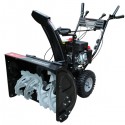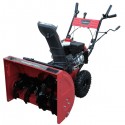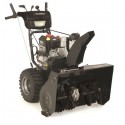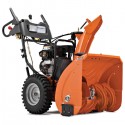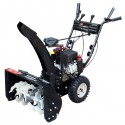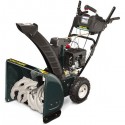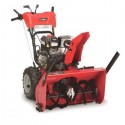Snow Blower Buying Guide
These are the 10 best snow blowers based on product quality, customer satisfaction, and price:
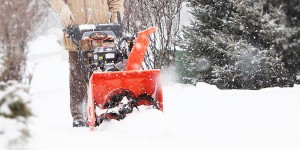 After many years of manually clearing my driveway and walkways using the old fashioned shovel and elbow grease method, I finally decided that I was sick and tired of back and shoulder pain, not to mention spending more time than I wanted working up a sweat in sub zero temperatures. I finally realized that a good, reliable snow blower is not at all expensive these days, and I got myself one. Now clearing my driveway and walkways is easier than ever, and I can do it in less than half the time it used to take me. Not only that, but I am not worn out or sore from the effort when I am done. That leaves me ready to enjoy all of the great things winter has to offer the garden, from watching winter birds at the feeder to simply relaxing by the fire and enjoying the winter wonderland outside my window.
After many years of manually clearing my driveway and walkways using the old fashioned shovel and elbow grease method, I finally decided that I was sick and tired of back and shoulder pain, not to mention spending more time than I wanted working up a sweat in sub zero temperatures. I finally realized that a good, reliable snow blower is not at all expensive these days, and I got myself one. Now clearing my driveway and walkways is easier than ever, and I can do it in less than half the time it used to take me. Not only that, but I am not worn out or sore from the effort when I am done. That leaves me ready to enjoy all of the great things winter has to offer the garden, from watching winter birds at the feeder to simply relaxing by the fire and enjoying the winter wonderland outside my window.
You will also find that switching to a snow blower is one of the best things you can do to make your winters more convenient and enjoyable. Millions of Americans injure themselves using manual snow shovels to clear their walks and driveways, and these injuries are totally avoidable. Whether you decide to go with a simple electric snow shovel that will clear smaller driveways and narrow walkways, a single-stage electric snow blower for slightly larger jobs, or a heavy duty two-stage gas snow blower for longer or unpaved driveways, your back and arms will thank you.
Snow blowers also save you a considerable amount of time when compared to using a manual snow shovel to clear the driveway. This is not only a convenient time saver; it is also much better for your health as well. You do not want to be working out by moving heavy, wet snow in freezing temperatures, as this is one of the best ways to lower your body’s natural defenses against the flu or common cold. And being outdoors in below zero wind chill for more than a half an hour can quickly put you at risk for frostbite, which believe me is something you will regret for the rest of your life.
There are three general types of snow blowers available: electric snow shovels, electric snow blowers, and gas snow blowers. Electric snow shovels are the smallest of the three types, and they are designed to handle light snow accumulation on smaller areas. Electric snow blowers are more powerful and larger than electric snow shovels, and can deal with deeper snow over somewhat larger areas. And gas powered snow blowers are the biggest and most powerful of the three kinds. Gas powered snow blowers can handle the heaviest snow accumulation and largest areas.
Gas and electric snow blowers come in a few categories of their own. Consumer grade snow blowers are the smallest of the three kinds, and are designed to clear the average suburban household’s driveway. They can handle up to about eight or ten inches of snow accumulation. Mid-sized snow blowers are a bit bigger and more heavy duty than consumer grade, and they can handle longer driveways, deeper snowfall, and heavier, wetter snow. Professional grade snow blowers are far and away the biggest and most powerful of the three. These are designed for clearing big areas very quickly, and they have the most durable parts. But they also have the highest price tags.
Because there is such a wide range of snow blower types, sizes, and styles, you should be able to find one that is perfect for your needs. If you have a rather small deck or patio to keep clear, and you do not expect much snowfall over the winter, and electric snow shovel should suffice. As properties, driveways, and walkways get bigger and longer, you can scale up your choice to electric or gas snow blowers, either single-stage or two-stage, depending on the kind of terrain you have. And if you are responsible for grounds keeping or have a landscaping business, a professional grade snow blower will serve your needs well.
There is also a rather wide range of prices for snow removal machines, and so you should also be able to find one that fits into your budget. The price tags can range from very affordable (in the case of more inexpensive electric snow shovels) to rather expensive (in the case of professional grade two-stage gas snow blowers). Of course, you will have to determine what your budget will allow as well as what kind of snow blower will be best for your needs.
1. Choosing The Right Snow Blower
1a. Clearance width
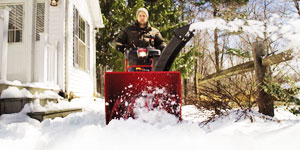 When you are choosing the right snow blower, the clearance width will be very important. Snow blowers with wider clearance widths will be able to clear the same area in fewer passes than smaller snow blowers can. Put simply, the fewer passes you have to make to clear an area means less time spent doing so. This is especially important if you have a fairly wide driveway or long walkways to keep clear. The less time spent outdoors clearing your driveway and walkways, the better. Not only is it inconvenient to be outdoors in cold, snowy weather, it can be downright dangerous: subjecting yourself to subzero wind chills for even a half an hour can result in frostbite. I highly recommend figuring out how wide your driveway is and dividing that amount by the clearance width of the snow blower you are considering so you know how quickly you can finish the job.
When you are choosing the right snow blower, the clearance width will be very important. Snow blowers with wider clearance widths will be able to clear the same area in fewer passes than smaller snow blowers can. Put simply, the fewer passes you have to make to clear an area means less time spent doing so. This is especially important if you have a fairly wide driveway or long walkways to keep clear. The less time spent outdoors clearing your driveway and walkways, the better. Not only is it inconvenient to be outdoors in cold, snowy weather, it can be downright dangerous: subjecting yourself to subzero wind chills for even a half an hour can result in frostbite. I highly recommend figuring out how wide your driveway is and dividing that amount by the clearance width of the snow blower you are considering so you know how quickly you can finish the job.
1b. Intake height
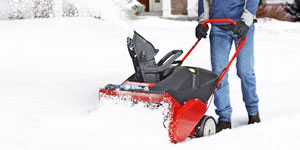 After clearance width, intake height is the next most important consideration that affects your snow blower’s performance and your snow clearing experience. Intake height determines how deep you can allow snow to get before your snow blower will be unable to effectively clear it. Intake heights range from four inches on the shortest electric snow shovels all the way up to two feet or more on two-stage professional grade snow blowers. The intake height you will require on your snow blower will be determined by how much snow you expect to get during heavy snow storms in your area. It should be a few inches taller than what the above average storm drops. That way, you can handle normal snow storms easily, and you will not be snowed in by heavier blizzards. Otherwise you may wind up having to make several trips outside to begin clearing snow while it’s still falling.
After clearance width, intake height is the next most important consideration that affects your snow blower’s performance and your snow clearing experience. Intake height determines how deep you can allow snow to get before your snow blower will be unable to effectively clear it. Intake heights range from four inches on the shortest electric snow shovels all the way up to two feet or more on two-stage professional grade snow blowers. The intake height you will require on your snow blower will be determined by how much snow you expect to get during heavy snow storms in your area. It should be a few inches taller than what the above average storm drops. That way, you can handle normal snow storms easily, and you will not be snowed in by heavier blizzards. Otherwise you may wind up having to make several trips outside to begin clearing snow while it’s still falling.
1c. Throwing distance
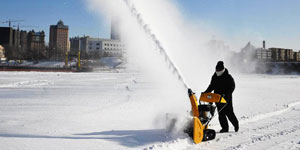 The throwing distance of the snow blower will affect its performance on wider driveways. Electric snow shovels can generally throw snow anywhere from ten to twenty feet, which makes them ideal for short driveways, patios and walkways. Mid grade snow blowers can throw snow over twenty feet, and professional grade two-stage snow blowers can often throw snow up to thirty feet away. When you are clearing a wider driveway, it’s easiest to do so by starting in the middle and working in a spiral pattern, because that way you do not have to adjust the throwing chute, but to do so you will need a snow blower that can throw snow across the entire distance from the center of the driveway to the edge. Otherwise you will have to clear snow in rows from one end to the other. The snow throwing capacity you will need depends on how big an area you have to clear.
The throwing distance of the snow blower will affect its performance on wider driveways. Electric snow shovels can generally throw snow anywhere from ten to twenty feet, which makes them ideal for short driveways, patios and walkways. Mid grade snow blowers can throw snow over twenty feet, and professional grade two-stage snow blowers can often throw snow up to thirty feet away. When you are clearing a wider driveway, it’s easiest to do so by starting in the middle and working in a spiral pattern, because that way you do not have to adjust the throwing chute, but to do so you will need a snow blower that can throw snow across the entire distance from the center of the driveway to the edge. Otherwise you will have to clear snow in rows from one end to the other. The snow throwing capacity you will need depends on how big an area you have to clear.
1d. Single-stage or two-stage
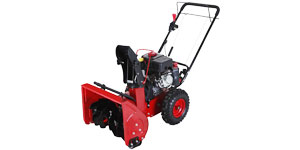 Single-stage snow blowers just have an auger, the paddle-like spindle that scoops up snow and throws it through the chute. Two-stage snow blowers are bigger and more heavy duty, and have an extra part, the impeller, which is like a fan that pulls snow up out of the auger and throws it through the chute. Single-stage snow blowers are available in electric or gas powered units, whereas two-stage snow blowers are only available as gas powered units. As a result, two-stage snow blowers are considerably more powerful than single-stage snow blowers. That lets them have wider clearance and taller intake heights. In addition, the auger on a single-stage snow blower makes contact with the ground, so it is better for use on paved, even surfaces. For surfaces that are unpaved or covered in gravel, a two-stage snow blower is necessary, because it won’t pick up and throw bits of gravel along with the snow.
Single-stage snow blowers just have an auger, the paddle-like spindle that scoops up snow and throws it through the chute. Two-stage snow blowers are bigger and more heavy duty, and have an extra part, the impeller, which is like a fan that pulls snow up out of the auger and throws it through the chute. Single-stage snow blowers are available in electric or gas powered units, whereas two-stage snow blowers are only available as gas powered units. As a result, two-stage snow blowers are considerably more powerful than single-stage snow blowers. That lets them have wider clearance and taller intake heights. In addition, the auger on a single-stage snow blower makes contact with the ground, so it is better for use on paved, even surfaces. For surfaces that are unpaved or covered in gravel, a two-stage snow blower is necessary, because it won’t pick up and throw bits of gravel along with the snow.
1e. Accessories
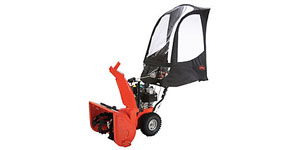 Snow blowers come with any number of useful accessories these days that can make the experience of clearing snow much more convenient and enjoyable. Halogen or LED headlights are particularly handy when you have to clear snow early in the morning or late in the afternoon on short winter days when sunlight is scarce. Drift cutters are an absolute must have if you live in an area that experiences heavy snowfall and strong winds. Skid shoes are very useful if you have uneven ground on your property; they help keep the auger level. Optional cabs made of clear plastic are invaluable if you find that you have to clear snow during a storm, which can often be the case. These protect you from wind and precipitation. And snow chains that attach to the snow blower’s tires help give them extra traction on icy, slippery surfaces for better control of the machine.
Snow blowers come with any number of useful accessories these days that can make the experience of clearing snow much more convenient and enjoyable. Halogen or LED headlights are particularly handy when you have to clear snow early in the morning or late in the afternoon on short winter days when sunlight is scarce. Drift cutters are an absolute must have if you live in an area that experiences heavy snowfall and strong winds. Skid shoes are very useful if you have uneven ground on your property; they help keep the auger level. Optional cabs made of clear plastic are invaluable if you find that you have to clear snow during a storm, which can often be the case. These protect you from wind and precipitation. And snow chains that attach to the snow blower’s tires help give them extra traction on icy, slippery surfaces for better control of the machine.
2. Snow Blower Types
2a. Electric Snow Shovel
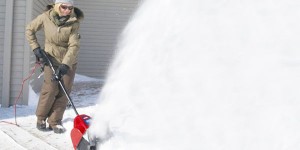 An electric snow shovel is the most basic upgrade you can make from a manual snow shovel. These machines are compact and lightweight. They have an auger that scoops up snow and throws it forward a short distance. That means you will have to exert a bit of human power to maneuver them around your deck, patio, or driveway, but they will do most of the work in terms of snow removal. Electric snow shovels are designed for areas that do not receive heavy snow storms that dump a lot of snow at one time.
An electric snow shovel is the most basic upgrade you can make from a manual snow shovel. These machines are compact and lightweight. They have an auger that scoops up snow and throws it forward a short distance. That means you will have to exert a bit of human power to maneuver them around your deck, patio, or driveway, but they will do most of the work in terms of snow removal. Electric snow shovels are designed for areas that do not receive heavy snow storms that dump a lot of snow at one time.
They are also meant to be used on smaller spaces, so they are perfect for a deck, walkway, or small driveway or parking space. If you no longer want or are able to easily clear snow by hand, but you do not live in a region that experiences heavy snowfall and your driveway is not too long, these can be a great purchase. These machines are perfect for people who do not have the strength level required to use a snow shovel but who also do not necessarily need to upgrade all the way to a snow blower.
Electric snow shovels have auger widths that average at about twelve inches wide. This is wide enough to efficiently clear a small area without being so wide that they will be difficult to maneuver or hard to find storage space for. As a matter of fact, most electric snow shovels are compact enough that you will probably be able to find space for them indoors in a broom closet or utility room. You’ll never know it’s there until you need to use it.
The intake heights on electric snow shovels are generally between four and eight inches. If you live in a region that rarely if ever experiences blizzards that drop more than six inches at a time, then an electric snow shovel should be able to handle the typical accumulation you are used to seeing. Unless you have a particularly large driveway, you should not have to purchase a heavier, bigger, and more expensive snow blower to take care of your property when you live in an area that does not get too much snow. An electric snow shovel should do the job just fine.
Electric snow shovels are also the most inexpensive snow removal machines. They are generally about half the price of electric or gas single-stage snow blowers, and they are considerably less expensive than mid-sized or professional grade two-stage gas snow blowers. This is important if your household is on a budget. And because they run on electricity rather than gasoline and are generally relatively low power machines, averaging around eight to ten amperes, they will not cause you to spend a lot of money keeping them running. In fact, you could save so much money on fuel or power costs alone by getting an electric snow shovel rather than an electric or gas snow blower that you may find it pays for itself in just a year or two.
2b. Electric Snow Blower
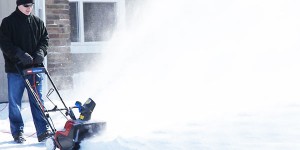 If you have a property that is a bit too big for an electric snow shovel to efficiently clear snow from, the next logical upgrade is to an electric snow blower. There are a number of reasons why opting to purchase an electric snow blower is a good choice. One of the most common reasons consumers choose to go with an electric snow blower over a gas one is the simple fact that electric snow blowers do not produce any emissions when you operate them. This is not only better for the environment, since the electric snow blower will not be belching out fumes or pollutants while you use it, it also saves you a lot of maintenance hassles and money in the long run for the same reasons an electric snow shovel does.
If you have a property that is a bit too big for an electric snow shovel to efficiently clear snow from, the next logical upgrade is to an electric snow blower. There are a number of reasons why opting to purchase an electric snow blower is a good choice. One of the most common reasons consumers choose to go with an electric snow blower over a gas one is the simple fact that electric snow blowers do not produce any emissions when you operate them. This is not only better for the environment, since the electric snow blower will not be belching out fumes or pollutants while you use it, it also saves you a lot of maintenance hassles and money in the long run for the same reasons an electric snow shovel does.
Electric snow blowers do not require changing out spark plugs, oil, or air filters, and when you have one you don’t have to keep smelly gas cans in the garage. You also will save a lot of money on fuel costs, since gas prices are considerably more expensive than electric power. Electric snow blowers are very easy to use, as well: you simply plug them in and you’re off. This means you will be able to get started clearing snow a lot more quickly.
And electric snow blowers run very quietly, which can be very important when you have neighbors: you never know when snow is going to fall, and you may wind up having to clear your driveway early in the morning before either the sun or your neighbors are up. With an electric snow blower, you do not have to worry about whether you are disturbing them by doing so.
Electric snow blowers have power loads that run up to about 15 amperes. This limits the size of the clearance width as well as that of the intake height. That means they are ideally designed to be used on medium sized driveways. And they will only be able to clear up to about a foot of snow accumulation before they begin to struggle. Therefore if you have a very large driveway or if you live in an area that regularly experiences heavy snow storms, an electric snow blower might not be able to do the job for you.
Electric snow blowers are single-stage machines, which means there is no impeller fan to throw snow and the auger mechanism makes contact with the ground. Because of this, they are not recommended for unpaved driveways or surfaces that are covered in gravel, as they will throw gravel and detritus along with the snow, presenting a serious safety hazard.
The price range for electric snow blowers runs from very affordable to rather expensive, depending on what you are looking for. The majority of electric snow blowers fall in the middle of the price range, and most households will find them very affordable. And just like electric snow shovels, the money they save on fuel costs is considerable.
2c. Gas Snow Blower
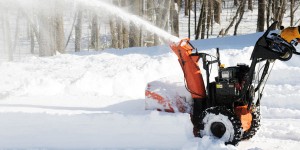 Gas snow blowers have one major advantage over either electric snow shovels or electric snow blowers: they are much more powerful than either. Because of this, gas snow blowers can support much wider augers and taller intake heights than their electric counterparts. Gas snow blowers are also the only ones that are available in both single-stage and two-stage units, so if you have a very big driveway or if you need to clear unpaved surfaces, a gas snow blower is the way to go. Gas snow blowers are also the best equipped to handle heavier, wetter snow. And if you live in an area that tends to experience fairly heavy snow accumulation on a regular basis, you are definitely going to want the kind of power that only a gas snow blower can provide.
Gas snow blowers have one major advantage over either electric snow shovels or electric snow blowers: they are much more powerful than either. Because of this, gas snow blowers can support much wider augers and taller intake heights than their electric counterparts. Gas snow blowers are also the only ones that are available in both single-stage and two-stage units, so if you have a very big driveway or if you need to clear unpaved surfaces, a gas snow blower is the way to go. Gas snow blowers are also the best equipped to handle heavier, wetter snow. And if you live in an area that tends to experience fairly heavy snow accumulation on a regular basis, you are definitely going to want the kind of power that only a gas snow blower can provide.
Gas snow blowers have engines that run from about 200 cubic centimeters to more than 400 cc. These engines can put out anywhere from 6 horsepower up to HP in the mid-20s. That allows them to have a very wide range of clearance widths and intake heights, so you can be certain that you will be able to find one that is right for the kind of area you need to keep clear. The auger widths on gas powered snow blowers can be as wide as three and a half feet on professional grade models. And the intake heights can get as high as nearly two feet tall. That means that they can handle just about any snow storm winter can throw at you.
The throwing distance on a gas snow blower will be considerably farther than on electric snow blowers, which is advantageous if you have a very wide driveway. Two-stage gas snow blowers, with their additional impeller fans, are excellent at throwing snow up to thirty feet away from the snow blower. With one of these models you can clear a big area of a deep accumulation of heavy, wet snow quickly and efficiently. Two-stage models also allow you to clear unpaved surfaces without worrying about picking up gravel or detritus.
Gas snow blowers do require more maintenance than electric snow blowers do, so you will need to be comfortable occasionally changing a spark plug or swapping out the oil, but if you are, you will find that they also provide much better performance over the long term. That’s because a combustion engine simply provides more power – and does so more reliably – than an electric engine can. While an electric snow blower will do just fine on smaller to medium sized suburban paved driveways, for bigger, tougher jobs you are going to want a gas snow blower.
Gas snow blowers also run the gamut from fairly affordable, consumer grade single-stage models up to heavy duty, professional grade two-stage models, which can get to be very expensive. The biggest and most expensive models are designed for landscaping businesses or grounds keeping crews to use, so if you have a typical residential property you will do just fine with a smaller model.
These are the 10 best snow blowers based on product quality, customer satisfaction, and price:

